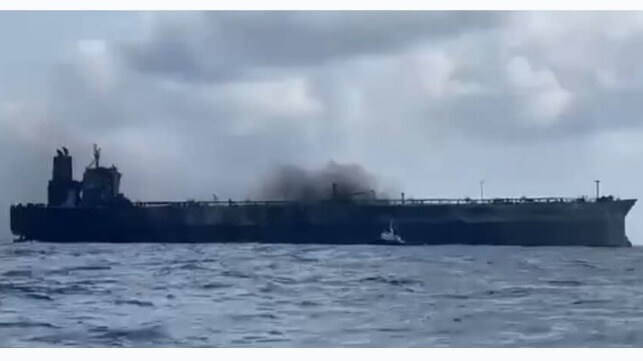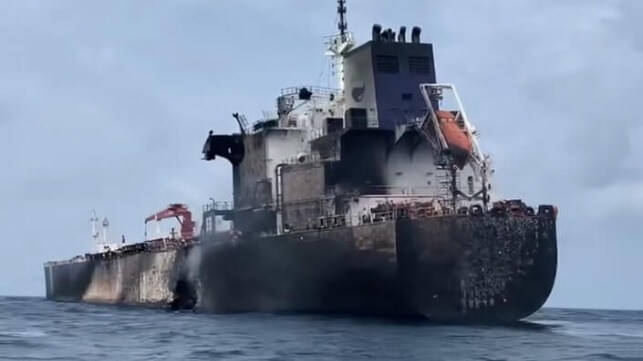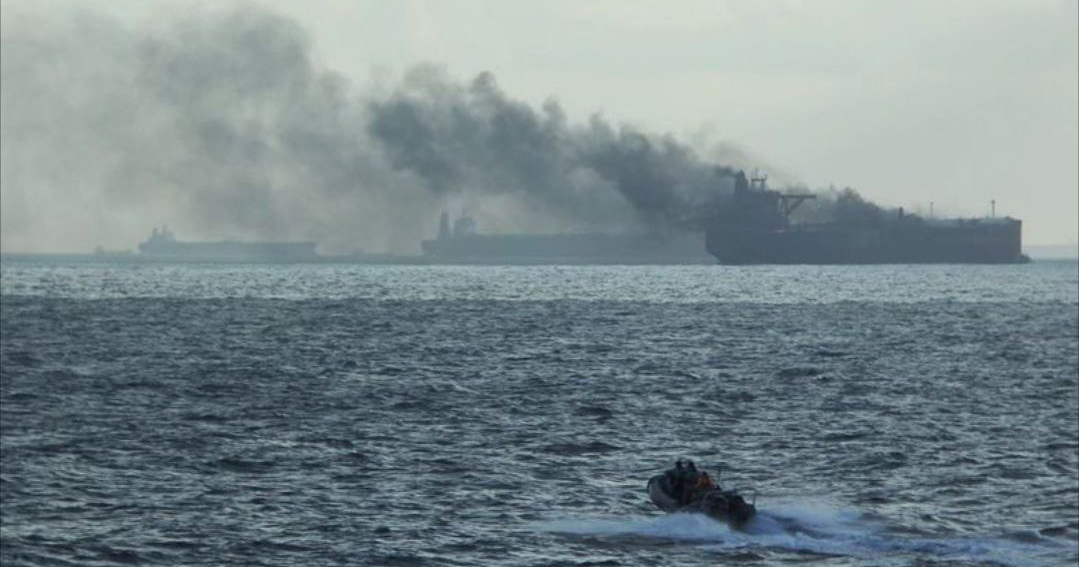UPDATED
Malaysia Apprehends Shadow Tanker After it is Towed from Scene of Accident

The mystery around Friday’s casualty involving a Hafnia chemical tanker and a VLCC near the eastern side of the Singapore Strait deepened as Malaysia confirmed it was searching for the Chinese-owned crude oil tanker. Overnight on Sunday, Malaysian Maritime apprehended that tanker as it was being towed, along with two tugboats.
Malaysian officials told a press event on Saturday that they had numerous concerns about the VLCC Ceres 1, which is registered in São Tomé and Príncipe. During the briefing, officials said, “So far, Malaysian Maritime has not been able to confirm the actual condition of the ship and crew of MT Ceres 1 since it is not contactable.”
At approximately 0120 Sunday, July 21, one of Malaysian Maritime’s patrol boats detected and overtook the Ceres 1 at a position 28 nautical miles northeast of Tioman Island, which would be as much as 80 nautical miles north from the position where the two vessels made contact on Friday morning. The offshore patrol vessel KM Pekan also took into custody two tugs that were towing the damaged VLCC.
Malaysian video from Friday showing Ceres 1 during the rescue effort
Malaysia had dispatched two offshore patrol boats to the area on Saturday only to discover that the Ceres 1 was no longer at the scene of the accident, which was approximately 25 nautical miles east of Malaysia. The officials accused the Ceres 1 of turning off its AIS signal and moving from the scene of the accident. They were also using an amphibious aircraft aloft to search for the tanker, which they believed was still likely in Malaysian waters.
“Information and review of MRSC Johor Bahru together with the Malaysian Maritime Department also found the IMO registration number of the concerned ship is suspicious and the actions of the concerned ship leaving the incident area is also doubtful,” Malaysian Maritime said in its statement.
On Friday, a Singapore-flagged supply ship, Dolphin 1, responded to the distress calls and a call for assistance from the Maritime and Port Authority of Singapore and rescued 14 crewmembers from the Ceres 1 shortly after the incident. Two of the crewmembers were airlifted by the Singapore Air Force to a hospital for further treatment while the reports said 26 crewmembers remained aboard the Ceres 1 to continue the firefight.
The Ceres 1 has widely been linked to the sanction-busting trade in Russian, Iranian, and Venezuelan oil. Ownership is reported as a company in Hong Kong, but reports said its P&I insurer was unclear. Iran’s Energy Ministry issued a statement on Saturday saying it did not have oil aboard the Ceres 1 contradicting prior reports that the vessel was loaded with as much as 2 million barrels of crude. Images of the tanker from Malaysia’s video show the Ceres 1 riding high, confirming it had offloaded before the incident.
Malaysian video showing extensive damage to the Hafnia Nile
Analysis of the tracking data shows the Hafnia Nile traveling at 14 knots before the casualty. AIS transmissions from the Ceres I appear to suggest that it was at anchor, based on data provided by Pole Star, but its traffic history showed irregularities consistent with extensive spoofing, according to Lloyds Intelligence.
The Hafnia Nile was abandoned with its crew taken to Singapore. Hafnia in a statement said two crewmembers had suffered minor injuries. The fire aboard the product tanker which was loaded with 300,000 barrels of naphtha according to Kpler and LSEG caused extensive damage on the port quarter of the vessel.
Malaysia reports it has also spotted an oil slick in the area of the impact. They are now leading the investigation into the circumstances of the incident.
Malaysia Reports Tankers are Secured as Efforts Shift to Investigation

Speaking to reporters on Monday officials with the Malaysian Maritime Enforcement Agency said their portion of the efforts surrounding the collision of two tankers on Friday is now winding down with the emphasis on the investigation into the circumstances of the accident. They have confirmed that all the crewmembers are now safe and reported that both tankers are being secured.
The Chinese VLCC Ceres 1 was towed to “a safe area” approximately 20 nautical miles east of Tanjung Sedili on the southeastern portion of the Malaysian peninsular and north of the collision location near the eastern end of the Singapore Strait. MMEA said they had been told by the captain of the Ceres 1 that the 26 crewmembers that remained aboard the ship were safe.
An additional 14 members of the Ceres 1 crew along with all 22 crew from the Hafnia Nile are being accommodated in Singapore. They were taken there on Friday during the evacuation efforts while the tankers were on fire.
Malaysia officials said the Hafnia Nile will also be towed to a similar location to facilitate the investigations. Hafnia said on Saturday that the fire was out aboard the ship and salvage experts were beginning their surveys of the vessel. The ship was drifting, but officials said it was not a hazard to navigation. Hafnia told S&P Global that the vessel is secured with tugs while S&P reports a ship-to-ship transfer of the naphtha cargo is being planned.
During the next phase of the operation, Malaysia’s Department of the Environment is responsible for the environmental efforts. An overflight of the area around the collision was reported to show a small amount of oil. The Ceres 1 appeared to be empty at the time of the incident while the Hafnia vessel was transporting a cargo of naphtha to Japan.
The mystery had intensified in the hours after the incident when officials from Malaysia said the VLCC had gone dark and left the area. They launched a search of Malaysian waters and found the vessel shortly after 0100 Sunday. It was being towed by two tugs and all three vessels were seized by Malaysia.
Officials declined to provide any additional details on the nature of the incident and anything they may have learned. The VLCC which is well known as part of the shadow fleet was indicating it was at anchor but has a history of false AIS transmissions. The Hafnia product tanker was bound for Japan and transiting the strait at a speed of 14 knots. There is no indication of weather that could have been impacting the area when the two vessels made contact.
22 July 2024 -
A handout image shows the RSS Supreme's rigid-hulled inflatable boat in the vicinity of the burning vessels following a fire on two oil tankers about 55 km (34 miles) northeast of the Singaporean island of Pedra Branca, July 19, 2024.
A tanker that was involved in a collision near Singapore last week entered the area of Malaysia's Bertam floating oil terminal on Monday morning after it was intercepted by local authorities on Sunday, shipping data from LSEG and Kpler showed.
The Sao Tome and Principe-flagged supertanker Ceres I left the scene of a fiery collision with another tanker, the Singapore-flagged Hafnia Nile, on Friday
The Ceres I was found in Malaysian waters with two tugboats towing it, the coast guard said in a statement on Sunday.
The Ceres I and the two tugboats have been detained by the coast guard for further investigation, it said.
The Bertam floating production, storage and offloading (FPSO) terminal is located in the South China Sea off the east coast of Peninsular Malaysia.
The Ceres I is a very large crude carrier (VLCC) supertanker capable of carrying around 2 million barrels of oil. AIS data on LSEG showed that Ceres I is empty.
Ceres I has loaded crude and fuel oil from Iran and Venezuela through ship-to-ship transfers between 2019 and March 2024, Kpler data showed.
Shanghai Prosperity Ship Management is the manager of the Ceres I, according to LSEG data. The company could not be immediately reached for comment.
Separately, Hafnia, the manager of Hafnia Nile, said over the weekend it was in discussions with Malaysian authorities to safely move the vessel.
The Hafnia Nile, a 74,000-deadweight-tonnes capacity Panamax tanker, was carrying about 300,000 barrels naphtha for Japan, according to ship-tracking data from Kpler and LSEG. Naphtha is a raw material for making petrochemicals.
Singapore is Asia's biggest oil-trading hub and the world's largest bunkering port. Its surrounding waters are among the busiest global sea lanes.
Malaysia's coast guard said on Sunday that aerial surveys conducted by the coast guard found minor traces of an oil spill at the location of the collision between the Ceres I and the Hafnia Nile, which occurred in the waters about 55km (35 miles) northeast of the Singaporean island of Pedra Branca.
“The environment department has been informed and will conduct further monitoring,” it said.
Reuters
Ceres I left collision site and turned off its tracking system on Friday
The Sao Tome and Principe-flagged tanker Ceres I, which had left the collision site and turned off its tracking system, was found in Malaysian waters being towed by two tugboats.
Both the tanker and the tugboats have been detained for investigation, the coast guard said in a statement.
Aerial surveys showed minor oil spill traces at the collision site and the environment department said it will conduct further monitoring.
Zin Azman Mohamad Yunus, the head of the Malaysian coast guard’s search and rescue team, has not provided an explanation for why the tanker attempted to flee. He, however, said further investigations will be conducted.
The tanker collided with the Singapore-flagged Hafnia Nile on Friday, resulting in fires on both vessels. The collision occurred in the waters about 55km northeast of the Singaporean island of Pedra Branca.
Singaporean officials reported that all crew members from both ships were rescued.
“A first assessment on board the vessel confirms that no visible flames are observed,” Hafnia said. “Pollution levels around the vessel are still undetermined.”
According to ship-tracking data from Kpler and LSEG, the Hafnia Nile, a Panamax tanker with a capacity of 74,000 deadweight tonnes, was carrying approximately 300,000 barrels of naphtha.
The supertanker Ceres I entered the area of Malaysia’s Bertam floating oil terminal on Monday morning after it was intercepted by local authorities on Sunday, Malaysia’s The Star reported.
The Ceres I, built in 2001, is part of the sanctions-busting “dark fleet” that transports oil from countries under sanctions.

The area where Ceres I had been anchored is known to be used by “dark fleet” ships for the transfer of Iranian oil in contravention of US sanctions, Michelle Wiese Bockmann, principal analyst at Lloyd’s List Intelligence told Reuters on Friday.
Matt Stanley, head of market engagement for EMEA & APAC with Kpler, said the Ceres I has “gone dark” numerous times, meaning it has frequently turned off its Automatic Identification System tracking transponders.
According to the Equasis database, the vessel has been owned and managed by the Chinese company Shanghai Prosperity Management since 2019, Seatrade Maritime news reported.
An oil spill was detected at the site of the collision.
Hannah Martens | July 22, 2024, MOTHERSHIP
The Malaysian coast guard has detained an oil tanker involved in a collision with another ship near Pedra Branca.
On Jul. 21, it shared in a statement on Facebook that it had detained the Sāo Tomé and Príncipe-flagged tanker, the Ceres I, after it left the site of the Jul. 19 collision.
Collision
On Jul. 19, a Singapore-flagged tanker, the Hafnia Nile and the Ceres I collided about 55km northeast of Pedra Branca, causing both ships to catch fire.
The Republic of Singapore Navy vessel picked up all 22 crew from the Hafnia Nile.
A Singapore-flagged supply vessel in the vicinity picked up 14 crew members from Ceres 1.
Two were evacuated by a Republic of Singapore Air Force helicopter to Singapore General Hospital for medical attention.
26 crew remained on board, conducting fire-fighting operations.
Detained
In a statement on Facebook, the Malaysian coast guard said it discovered that the Ceres I left the scene of the collision on Jul. 21.
On Jul. 22, an offshore patrol vessel belonging to the Malaysian coast guard successfully located and detained the tanker and two tugboats.
Based on reports, the tanker and tugboats were found 28 nautical miles northeast of Tioman Island.
The two tugboats were suspected of being involved in the Ceres I's departure from the collision site.
The Malaysian Maritime Authority will carry out further investigations of the incident.
The coast guard's air survey results also revealed traces of an oil spill at the location of the incident.
The Malaysian Department of Environment has been informed of this discovery and will monitor the issue.



No comments:
Post a Comment